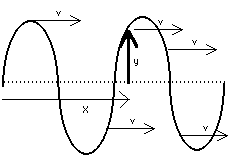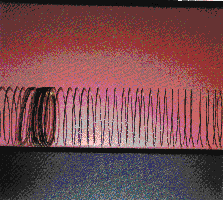

In general, there are two kinds of waves:
For transverse waves, the individual disturbance is perpendicular to the direction of the wave motion as a whole.

A wave on a string or a wave on a rope is an example of a transverse wave. Light is also a transverse wave; Light is an electromagnetic wave. Light is a transverse wave caused by changes -- or disturbances -- in the electric field and magnetic field. No medium is required for light or other EM waves.


A wave along the length of a Slinky -- as shown above here -- is a good example of a longitudinal wave. Sound is another longitudinal wave. Sound is a longitudinal wave through the air. Sound can also travel through water, a liquid, or through the Earth, a solid.
|
|
|
||
(C) 2003, Doug Davis; all rights reserved